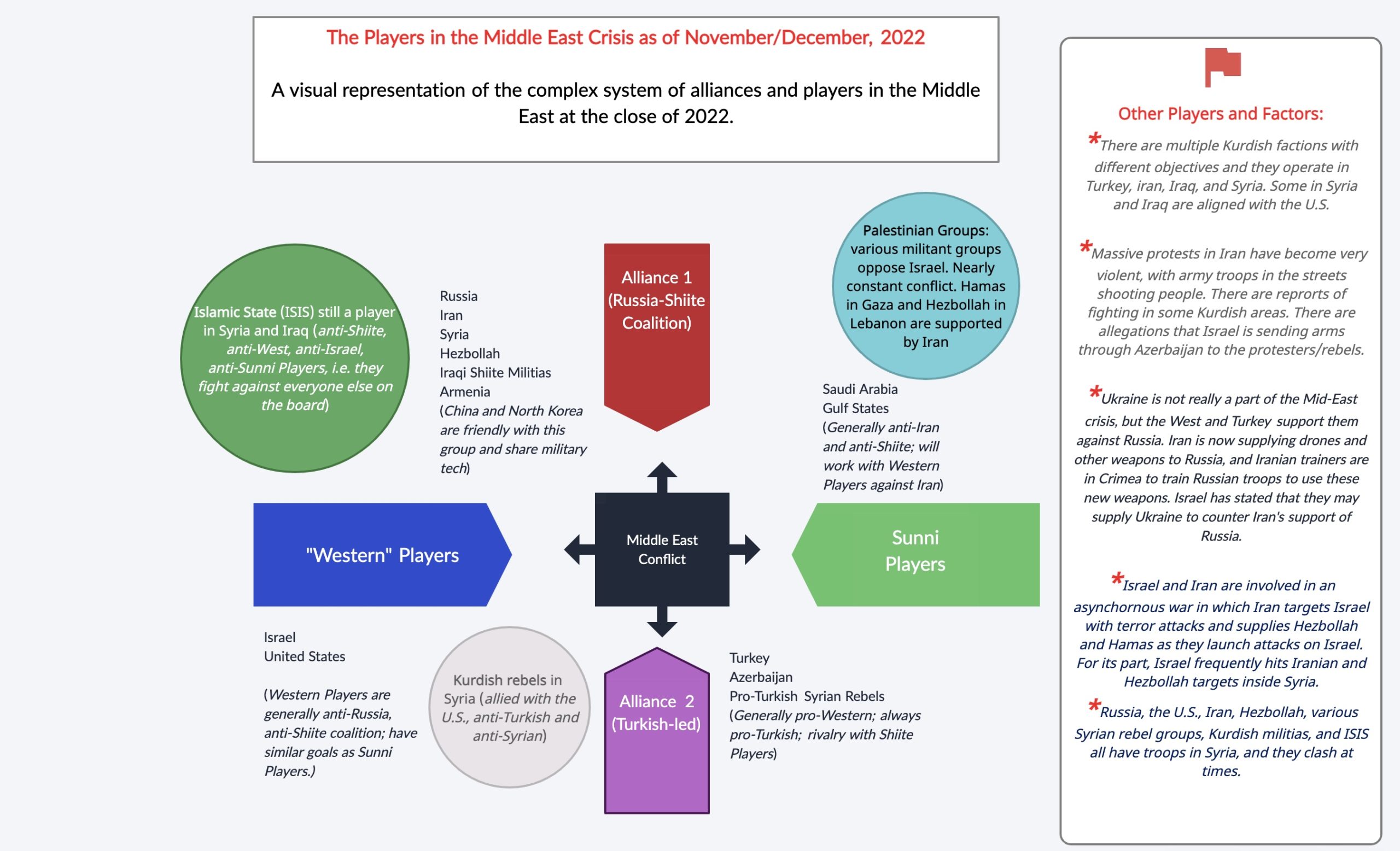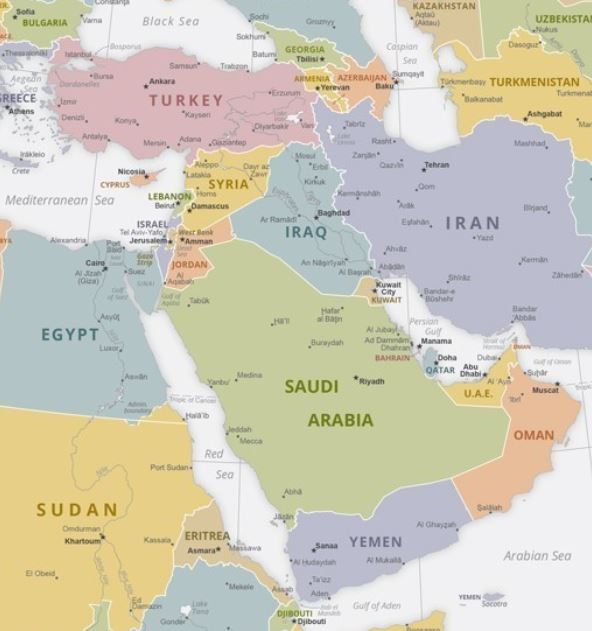
Middle East Crisis Update -November, 2022
Middle East Crisis Update -November, 2022
In terms of major conflicts in the world, most attention remains, and rightfully so, on Russia’s continued aggression in Ukraine. However, we need to also be aware that the situation in the Middle East (including parts of the old Soviet Union) are also inching closer to open conflict between some major players.
In the past week or so, tensions involving Turkey, Syria, Iraq, Iran, Azerbaijan, and Armenia have all increased. Turkey is openly attacking Kurdish militia positions inside Syria, and in Iraq, and the Syrian military has taken casualties. At last report, Turkey is gearing up for a major land offensive inside northern Syria.
In Iran, protests against the authoritarian theocracy have grown, with Iranian security forces, including the army, using increasingly violent methods to suppress the protests. Some protesters are also appearing in public with military-grade weapons. This is where protesters become rebels, and is very similar to the opening rounds of the Syrian Civil War.
Speaking of Iran, tensions with neighboring Azerbaijan have increased since Azerbaijan defeated their old foe, Armenia in the Second Karabakh War two years ago. Armenia is allied with both Iran and Russia, while Azerbaijan is allied with Turkey. Also, Azerbaijan is developing pretty friendly relations with Israel, a nation that has been on Iran’s hit list for decades. Strategically, Turkey and Iran are competing for influence in the same areas. Turkey is forging relationships with other “Turkic” nations, such as Azerbaijan, Turkmenistan, and other Central Asian states. Iran is also trying to win over the Central Asian states, and is finding itself in competition with Turkey.
This is how this regional power competition is playing out:
On one side, we have an alliance that includes Iran, Syria, Russia, and their tributary states and groups. Russia has military forces in Syria, as part of a military intervention that began in 2014 to rescue the Assad dictatorship from a multi-sided civil war. Iran also has military forces in Syria, also in support of Assad. That makes Syria a satellite of both Russia and Iran. Then, we have the Lebanese Shiite militia (really, it is almost a state within a state) in Hezbollah. Also a proxy for Iran, and allied also with the Assad regime in Syria. Then there is Armenia, which has been under Russia’s wing for some time. Armenia has a long-standing and justifiable fear of Turkey (going back to the Turkish genocide of the Armenians in the World War One era). This partially explains Armenia’s alliance with Iran also, as a counterweight to Turkey (especially now that Russia is very much distracted by their ongoing aggression in Ukraine). Also, there are Shiite militias in Iraq that are also heavily allied with Iran.
On the other side, we have regional power Turkey (a majority Sunni Muslim nation, by the way), which has troops in northern Syria and is allied with Azerbaijan. Turkish troops in Syria are officially to protect Turkey from anti-Turkish Kurdish rebels, but also to support anti-Assad Syrian rebels. To say that the Erdogan government of Turkey is not on good terms with Assad in Syria would be an understatement. In mid-November, 2022, Turkey announced a major land offensive in northern Syria in order to hit Kurdish militias there. Some of these Kurdish groups are allied with the U.S., who sees these Kurds as a bulwark against ISIS and the Assad regime.
Turkey’s recent airstrikes in Syria and Iraq against the Kurds also ends up targeting bases that American troops in Syria share with the Kurds. On November 23, 2022, a Turkish attack on a Kurdish target in Syria almost hit American forces also stationed at that base. It should be noted that America and Turkey are both members of NATO!
Also, around the same time, Iran announced a troop buildup on their border with Iraq to, as they claimed, halt infiltration of Kurdish rebels from Iraq. Northern Iraq is largely an autonomous zone governed by Iraqi Kurds. The area also hosts both Kurdish Turkish rebels, and Kurdish Iranian rebels.
How Likely is a Major Regional War Involving Turkey and Iran?
The history of the Middle East, since the onset of the Arab-Isaeli Wars in 1948, has been a confusing and complex multi-sided conflict that engulfs not just the well-known Israel-Arab dynamic, but also, until the fall of the Soviet Union, included Cold War rivalries, as well as the rise of Islamic fundamentalism. In addition to the Jihadist (both Sunni and Shiite) antipathy toward the West and Israel, clashes between more secular Middle East nations and fundamentalist forces has also driven conflict. Plus, a virtual Islamic civil war has pitted Sunni powers (such as Saudi Arabia), against the main Shiite regional power (Iran) and their various proxies. Add to all this the modern interventions by outside powers (mostly America and Russia-though China is now making inroads in the region), largely over oil resources and strategic gamesmanship between them, and we see a heady mix of alliances, rivalries, and animosities.
The current issues between Turkey, Syria, Iraq, Iran, Azerbaijan, and Armenia, plus the various Kurdish factions, many of whom have allies in either America or Russia, create a very dangerous mix that may explode at any moment. Realistically, Turkey and Iran will probably not go to war against each other, unless one or the other seriously threatens the existence of one of their allies. Proxy warfare is most likely, though the history of that region since the 1940s show that almost anything is possible.
State of the World will provide updates as events warrant.
State of the World is a free newsletter, but if you like my work and would like to contribute a few dollars a month to support this newsletter, you can do so here. Your support is greatly appreciated.

